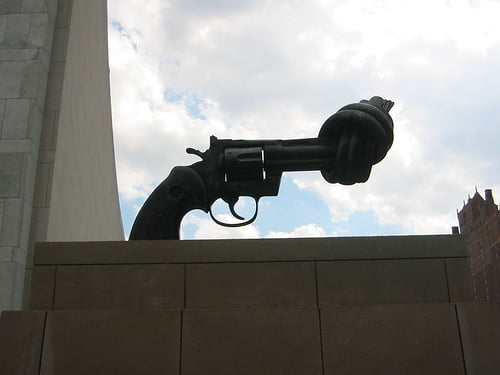It’s been a tumultuous few weeks at the United Nations as Member States have attempted to hammer out the text of a binding treaty controlling the flow of armaments between themselves. With the finish line closing in, the Chair of the Arms Trade Treaty Conference yesterday circulated the first consolidated draft text of the treaty. For all the hours that have gone into the drafting, the result clearly illustrated the limitations rules demanding consensus have brought about.
The representatives have produced a text that has been watered down tremendously from the original draft that was produced in March by the Conference’s Preparatory Committee. In that first version, not only was ammunition covered by the Treaty, a provision that the United States has called a red-line and refused to accept, but also the components and materials that make up the weapons listed in the UN Register on Conventional Weapons. While the text expands the scope slightly beyond the Register, to include Small Arms and Light Weapons, it goes nowhere near as far as activists have been pushing for.
Indeed, the draft treaty has already been compared to a “leaky bucket” by Oxfam’s Anna MacDonald, and panned as extremely weak and riddled with loopholes by NGOs and academics alike. Global Policy Journal provided a useful run-down of some of the larger problems with the draft:
1. The Goals and Objectives of the draft treaty (Article 1) focus on the ‘illicit trade.’ However, ‘legitimately’ traded weapons are also used in the commission of human rights and humanitarian law violations and most ‘black market’ arms start out in the licit sector before being diverted.
2. The Scope of the treaty has been watered down considerably from already weak earlier texts that had circulated in the conference’s committees. Rather than covering all conventional weapons (Article 2, Section A), it limits the treaty to the seven categories of arms covered by the UN Register on Conventional Weapons plus small arms and light weapons. The glaring omission of ammunition, the inclusion of which is supported by a majority of states, is deeply concerning. Moreover, the text does not include the reference to “unmanned” weapons – such as drones – that was, without major objection, consistently included in committee drafts.
3. The draft text (Article 2, Section B) focuses on ‘trade’ and ‘export’ of weapons, rather than ‘transfers’, leaving undefined whether it would cover gifts, loans and leases of weapons.
4. While aiming to prevent arms deals that would facilitate war crimes, violations of human rights and humanitarian law, terrorism and destabilization, Articles 3, 4 and 5 leave broad latitude for states to define the authorization process for weapons transfers, leaving them considerable room for maneuver.
5. Article 6 prevents states from using to ATT as ‘grounds for voiding contractual obligations under defense cooperation agreements.’ In other words, if a contract to transfer weapons and military assistance already exists, and one party started to commit human rights abuses, the other parties to the transfer might not be allowed to halt deliveries of weapons or cancel the contract. This is a serious loophole.
6. The draft requires 65 countries to ratify the treaty before it enters into force. This will create a lengthy delay in starting implementation. Control Arms recommends 30 countries as the threshold before implementation.
Left out from this list is the lack of an enforcement mechanism designed into the language. Instead, it calls upon States to “adopt national legislation or other appropriate national measures, regulations and policies as may be necessary to implement” the Treaty. It also provides for a small ‘Implementation Support Unit’, to aid States in the fulfillment of the reporting they’d be required to provide.
With the Conference set to close tomorrow, it is unlikely that a major breakthrough will be produced that will strengthen the language of the treaty; drafts that are produced through consensus are usually weakened at this stage, not bulked up. Further, it is unlikely that states that have pushed for the Treaty to come about will play the role of spoiler by refusing to sign off on a weakened text, killing it before it can be signed.
However, the language also may not be completely static. The treaty draft calls for a Conference of State Parties to meet no later than one year after the entry of this treaty into force, at which point any suggested Amendments to the Treaty may be discussed. With that, though, comes the risk that States will utilize Article 18 and withdraw from the Treaty entirely.
The final Arms Trade Treaty, as weak as it will likely wind up being, may yet serve a purpose. For all its faults, it still remains the first piece of international law designed specifically to monitor and regulate the flow of legal arms sales between states, a breakthrough in itself. We also may yet be surprised by the final text. According to Ewan Buchannan of the United Nations Office for Disarmament Affairs, the talks are likely to go very late into the evening tomorrow. A breakthrough may yet still be possible.
